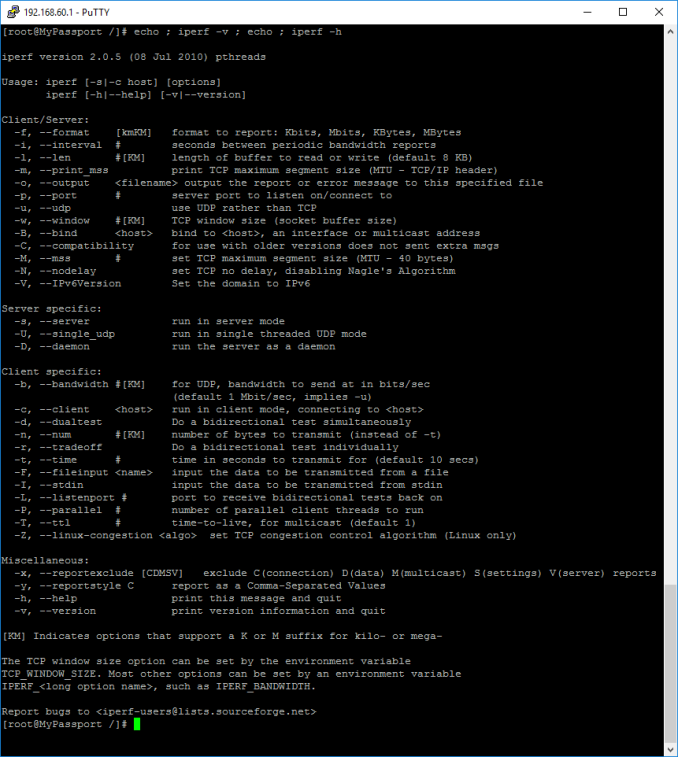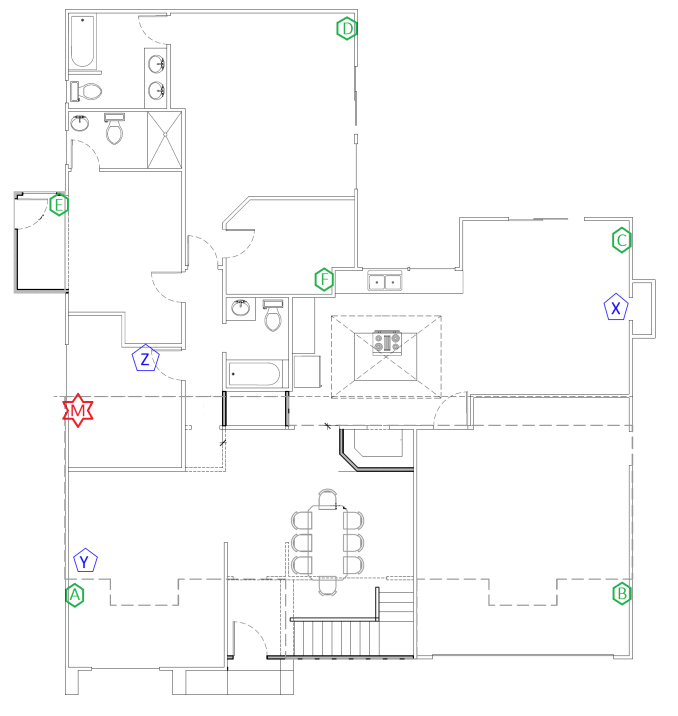Western Digital My Passport Wireless Pro Wi-Fi Hard Drive Review
by Ganesh T S on June 21, 2016 8:08 AM EST- Posted in
- Storage
- Western Digital
- Gadgets
- wireless storage
Wireless Benchmarks
Our review of the My Passport Wireless loaded up video files of varying bitrates into the device and tried to stream them to various devices to determine the effectiveness of the WLAN component. The range factor was addressed using a W-Fi strength analyzer app on a smartphone. The My Passport Wireless Pro makes it necessary for us to adopt a different strategy, as the dual-band aspect also deserves attention. Fortunately, the SSH access and software capabilities of the My Passport Wireless Pro allows us to utilize iperf for benchmarking the Wi-Fi capabilities. The OS running on the unit ships with iperf v2.0.5 pre-installed.
Two of the striking differences in the WLAN specifications of the My Passport Wireless and the Pro are the presence of a 5 GHz 802.11ac radio in the latter and the downgrade from a 2T2R 2.4 GHz 802.11n solution in the former to a 1T1R one in the Pro. Western Digital indicated that they are targeting the My Passport Wireless Pro for high-performance applications in close-range scenarios, and the 2.4 GHz band is retained only for legacy reasons.
Our evaluation strategy consists of using iperf to determine TCP and UDP downlink and uplink rates at three different locations (marked X, Y and Z in blue) in a 1800 sq. ft. home, as indicated below. While the My Passport Wireless Pro (set up at location M in the floorplan) was set as the server node, an Intel D54250WYKH NUC running Windows 10 Pro x64 was used as the client at the three different locations. The NUC sports an Intel Dual Band Wireless-AC 7260 2T2R 802.11ac solution.
The purpose of our benchmarking was not to tune the stream configuration for obtaining maximum possible bandwidth. Rather, we wanted to replay the same stream across multiple locations in order to determine comparative performance. iperf with default parameters was used for benchmarking. On the 'server', we ran the following command:
TCP: iperf -s -B 192.168.60.1
UDP: iperf -s -u -B 192.168.60.1
The 'client' was connected to it using the following command:
TCP: iperf -c 192.168.60.1 -P ${num_parallel_streams} -t 30
UDP: iperf -c 192.168.60.1 -u -b ${curr_bw_to_test}m -t 30
The number of parallel streams were tested between 20 and 25 for the TCP case. The maximum obtained bandwidth was recorded. For the UDP case, we altered the bandwidth to test in order to arrive at the value that resulted in less than 1% packet loss during transmission. The roles of the server and client were then reversed, and the same benchmarks were processed.
The numbers below were recorded with the unit in standalone wireless NAS mode. Using it as a Wi-Fi access point with uplink in the same band as the usage band is bound to bring down the numbers even further.4
| Western Digital My Passport Wireless Pro 2TB WLAN Benchmarks (Mbps) | ||||||||
| 2.4 GHz SSID | 5 GHz SSID | |||||||
| TCP DL | TCP UL | UDP DL | UDP UL | TCP DL | TCP UL | UDP DL | UDP UL | |
| Location X | 9.82 | 14.3 | 9.17 | 17.2 | SSID Not Visible | |||
| Location Y | 33.7 | 26.6 | 34.8 | 32.8 | 37.3 | 5.32 | 37.5 | 8.19 |
| Location Z | 80.9 | 67.7 | 84.3 | 75.4 | 183 | 114 | 197 | 126 |
Wi-Fi numbers are heavily dependent on the usage environment, and the only takeaways we have from the above are the fact that the 5 GHz SSID is handicapped by range issues, but, it outperforms the 2.4 GHz SSID when it comes to same-room usage (which is the typical use-case for the My Passport Wireless Pro). The hard drive or attached storage media access rates are unlikely to the source of bottlenecks when it comes to real-world data transfers involving the unit.












25 Comments
View All Comments
Impulses - Wednesday, June 22, 2016 - link
There ARE portable mini routers (sized like a pack of cards or smaller) with very similar functionality (card reader, battery, hotspot, etc) and a USB port unto which you can hook up any portable drive.marvdmartian - Thursday, June 23, 2016 - link
That's true. But for travel purposes, I'd rather have it all in one unit. Drop a hdd or ssd in there, and you're good to go, AND it's taking up less space in the carry-on bag. Space and weight are a premium, these days, if you're flying.mr_tawan - Sunday, June 26, 2016 - link
I saw some Chinese-made system with OpenWRT. Haven't tried but I expected to be better than WD :).Huppie76 - Thursday, July 21, 2016 - link
Hi. Is possible to putt a ssd into this device? How did you open it? Is it hard to open it?Tenx for the good review
windz - Wednesday, June 22, 2016 - link
Having the Plex media server in a portable Wi-Fi drive is bad ass. Finally I can stream all my MKV to my iPad Pro on the road.ravedog - Friday, June 24, 2016 - link
I don't think you mkvs will work in the iPad. The unit does not do any transcoding only straight thru playing. So the device doing the playback has to support mkv which I'm fault certain the iPad might not. (Unless there was a way to pipe the files into Vlc or infuse.)HanaAndHerSistersTech - Thursday, June 23, 2016 - link
Pass. Had two WD external USB drives die out in past six months, they were only a year old. Going to HGST now.Phynaz - Friday, June 24, 2016 - link
This thing will operate as a Plex media server, right? Why wasn't that aspect reviewed?wossman - Saturday, June 25, 2016 - link
I had the 2014 2TB model (before I accidentally dropped in onto my toes from about 2.5 feet and it never worked again) and the thing that frustrated me most about using it in DAS mode (which I did most often) was how quickly the drive would spin down. It seems like it would sleep after as little as 2 minutes of inactivity or less. And it took its own sweet time spinning up again, during which time most Windows 8.1 systems would lock up the UI of the app trying to access the drive.I searched high and low for a utility that would let me change the sleep timer of the drive but I never found one. Otherwise, the drive was fine. I'd only try this new version if I know that issue's been fixed or someone can recommend a way of changing the timer to something I prefer. I'm fine with the drop in battery life that would come with the change.
mr_tawan - Sunday, June 26, 2016 - link
I think they are Green drives, so that's normal. I think WD Green are re-branded as Blue now though.